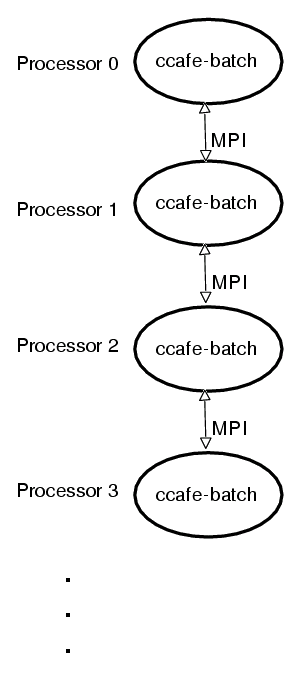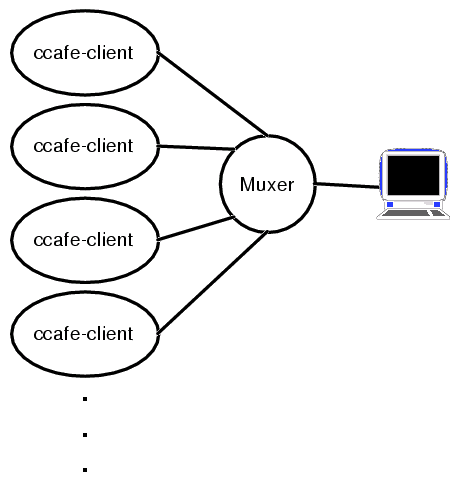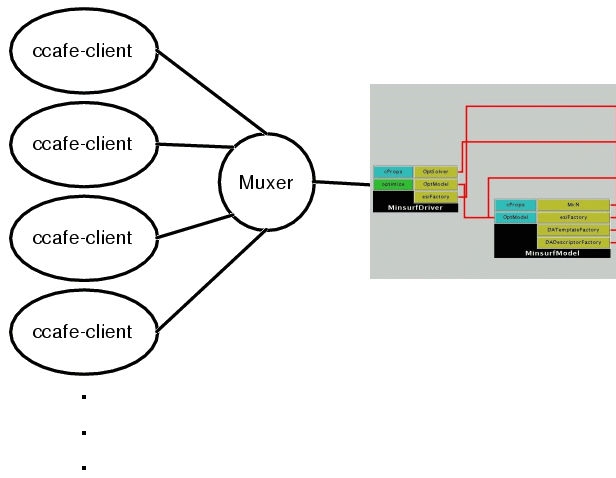Running Ccaffeine
Now that you have built Ccaffeine it would probably be nice to know how to run it. The Ccaffeine executable orchestrates a set of SCMD (Single Component Multiple Data) components on a parallel machine. It has the ability to instantiate, connect and run components interactively or in batch mode. Additionally, it has debug mode that runs as a single processor serial program. Ccaffeine itself has no ability to spawn processes and relies on MPI or PVM to do this task for it. For more information see the Ccaffeine paper. The rest of this document assumes a rudimentary understanding of the CCA component connection mechanisms and procedures.
The the ccaffeine executable comes in three distinct forms:
ccafe-client - client version that expects to connect to a multiplexer front end which can then be connected to the Ccaffeine GUI or a plain old command line for interactive work.
ccafe-batch - a batch version that has no need of a front end and has no ability to be interactive.
ccafe-single - a single process interactive version useful for debugging.
These executables are closely related and are intended to be useful in different modes of component-oriented software development ( see below ).
ccafe-single
This executable is meant to be run in single processor mode interactively with the command line.
Options for ccafe-single:
ccafe-single [--ccafe-rc < rc file >] [--help]
--ccafe-rc < rc file >
- Source the given file into ccaffeine.
--help
- Print out help information.
ccafe-batch
This executable is meant to run in a parallel environment, but does not have an interactive capability, nor the cumbersome multiplexing machinery that interaction requires. Since there is no way for the user to interactively create a component program, ccafe-batch requires either a command line --ccafe-rc option for a Ccaffiene resource file, a ~/.ccaferc , or a CCAFE_RC_FILE environment variable to perform parallel computations ( see below ).
Options for ccafe-batch:
ccafe-batch [--ccafe-rc < rc file > ] [--help]
--ccafe-rc < rc file > Source the given file into ccaffeine.
--help
Print out help information.
ccafe-client
This is the application for interactive use in a parallel environment. A copy of cafe-client runs on each participating processor, orchestrating and managing component creation, connections, and destruction on behalf of the user. A central multiplexor, called the Muxer, creates a single multiplexed communication stream out of the many cafe-client streams. The multiplexed stream communicates with the user through a GUI, or directly to a terminal. In order to preserve scalability, the Muxer's are self-similar and can be cascaded in a tree.
Options for ccafe-client:
ccafe-client [--type < client,interactive,gui,oneProcInteractive > ]
[--ccafe-waitForGdbAttach] [--port] [--ccafe-rc < rc file > ] [--help]
--type
More below:
--type client
This is the "normal" position, it listens for a
connection, probably the GUI. The backend right
now, always behaves as a client.
--type interactive
Same as client but interacts in human readable form,
rather than the way the GUI would be expecting to
interact.
--type gui
default behavior, expecting to talk to a GUI.
--type oneProcInteractive
Expects that there will be only one
process and that it will be talking to a human
being.
--port < number >
Port number to listen on, default host name is localhost.
--name < host >
Host other than localhost to connect to.
--file < configFile >
A processor config file for the processor map,
not an initialization file.
--ccafe-waitForGdbAttach
Spins until gdb attaches for debugging, probably not useful in
a parallel environment; every process would have to
be attached simultaneously.
--ccafe-rc < rc file >
Source the given file into ccaffeine.
--ccafe-outputdir < directory >
Ccaffeine creates files that are tied off to each process's
stdout and stderr. This flag causes those files to appear in the
specified directory.
--help
This message. \n
Ccaffeine Runtime Summary
Table 1. Ccaffeine run modes vs executables
| mode/executable | ccafe-single | ccafe-batch | ccafe-client |
| Parallel | N | Y | Y |
| GUI | N | N | Y[a] |
| interactive command line | Y | N | Y[b] |
| debug[c] (gdb attach) | N | N | Y |
| mpi-based components | N[d] | Y[e] | Y[e] |
| Notes: a. java muxer and builder gui req'd if used in parallel. b. Use telnet to the relevant Muxer port, specified by--builderPort on the Muxing process (default = 2024), also helpful but not neccessary is to specify --type interactive on ccafe-client. c. If ccafe-client run with --ccafe-gdbWaitForAttach and debugging symbols configured during the build, gdbWaitForAttach() occurs during startup. d. No serious reason for excluding this, just MPI_Init() is not called by Ccaffeine in this mode. e. Yes if mpi support configured into ccaffeine. | |||
A Ccaffeine resource file consists of a valid set of Ccaffeine commands and is loaded and run before interactive input begins. The Ccaffeine resource file is found and used in the following order of precedence for all of executables:
--ccafe-rc option
CCAFE_RC_FILE environment variable
$HOME/.ccaferc
$prefix/cxx/dc/user_iface/CcaffeineRC where $prefix is the value by the same name given to configure.
ccafe-single and ccafe-client if still not finding an rc file, bravely continue, waiting for the interactive input, ccafe-batch on the other hand, will exit.
In order to prevent unintended use of non-Ccaffeine files, a valid Ccaffeine resource file must have a "magic number" at the top of it:
#!ccaffeine bootstrap file.
# ------- don't change anything ABOVE this line.-------------
# ...
You should include the first two lines of this example file at the top of any rc file you wish to create for yourself. If these magic two lines are not present, the file will not be read by Ccaffeine and it will complain on start up. If the file $CCAFE_ROOT/cxx/dc/user_iface/CcaffeineRC is used as a resource file (directly from the Ccaffeine build), the components that come with Ccaffeine will be loaded automatically whenever Ccaffeine is started.
All executables, if given an invalid resource file, continue searching in the next possible rc file location, and issuing a warning about the bad file. If any rc file is subsequently found, another warning is issued that the rc file found is not the one expected.
Ccaffeine Scripting Language
At the command line Ccafeine is pretty much self documenting. Running ccafe-single at the command line and typing "help < CR >" gives:
help --
arguments: [string token]
prints the help of one or all commands
exit --
x --
bye --
quit --
arguments: [string token]
leave the parser and the calling program, with optional return code.
display --
arguments: < string token > [instance]
display pallet
- show what is in the pallet currently.
display arena
- show what is in the arena currently.
display component < component instance name >
- show the ports and class name associated with a component
display chain < component instance name >
- show the connections associated with a particular
display state
- equivalent to "display arena" and then "display chain"
pulldown --
instantiate --
create --
arguments: < class > [string token]
create an arena instance from a class.
connect --
arguments: < instance > < string token > < instance > <
string token >
< using instance > < used Port name > < providing instance
> < provided Port name >
- make a connection between two instantiated components
residing in the arena.
disconnect --
arguments: < instance > < string token > < instance > <
string token >
< using instance > < used Port name > < providing instance
> < provided Port name >
- break a connection between two instantiated components
residing in the arena.
configure --
parameters --
arguments: < instance > < string token > < string token >
[string token] [0 or args like previous]
query or set the configuration parameters of a component port
go --
run --
arguments: [instance] [string token]
cause the connection framework to run the framed components.
pallet --
classes --
show what component classes are in the pallet currently.
arena --
instances --
show what instances are in the arena currently.
links --
chain --
show what connections are in the arena currently.
property --
arguments: < instance > [string token] [remainder of line as a single
string]
property < component-instance-name >
- show all the properties of a component.
property < component-instance-name > < key >
- show all the named property of a component, if it exists.
property < component-instance-name > < key > < value >
- set the named property of a component.
remove --
arguments: [instance]
remove < component instance name >
nuke --
arguments: < string token >
remove all components in the arena
repository --
arguments: < string token > [string token]
repository list
- show components available in the repository.
The following get options cannot be abbreviated:
repository get class
- load component from the repository list (private and immediate
linking).
repository get-global class
- load component from the repository list (global and immediate linking).
repository get-lazy class
- load component from the repository list (private and lazy linking).
repository get-lazy-global class
- load component from the repository list (global and lazy linking).
Global linking may be appropriate for components that, as a side effect,
for example include libblas, liblapack, libppm, and other legacy C/f77
routines.Such components will need to be loaded before any other components that
use the
global symbols.
path --
arguments: [string token] [string token]
path init
- set framework path from env(CCA_COMPONENT_PATH).
path append < directory >
- add directory to path.
path prepend < directory >
- insert directory before path.
path set
- replace path. format input as env()
path
- show path
shell --
system --
arguments: [remainder of line as a single string]
executes shell commands (no globbing, though)
Configuration Files and File Confusion
There are 3 different files that Ccaffeine uses for configuration, beyond other files that might be associated with any components that get instantiated. In addition to these, ccafe-client creates files associated with the stdout/stderr of each process (these are usually named pErr xx and pOutxx, where xx is the MPI rank of the process ) . It is easy to confuse them and usually disasterous to program execution if they are mixed up. Only one file type is associated with ccafe-batch and ccafe-single: the Ccaffeine resource file . For ccafe-batch there are three configuration files:
A runtime configuration file indicated by the --file option.
A ".bld" file that is read by the Ccaffeine GUI .
Of these the most similar and the easiest to confuse are the ".bld" file and the Ccaffeine resource file. The ".bld" file is a format only for the GUI front end and is only read and parsed only by the GUI. Ccaffeine proper (i.e. ccafe-client) will get confused by it and probably hang. The ".bld" file can both be read and written by the GUI . It can also be carefully edited by the user, usually with reasonable results. The Ccaffeine resource file is never written by Ccaffeine and is only constructed by the user from the valid list of Ccaffeine commands .
The Ccaffeine GUI
The Ccaffeine GUI takes the place of a user typing at a command line terminal. It interprets gestures in the window and translates them into commands to be typed out on a socket that is connected to the Muxer , which in turn sends them to the ccafe-client's. The GUI always assumes that it is talking to a single Ccaffeine client and requires the Muxer to communicate in to a parallel run. Obviously the GUI can only be used in an interactive fashion and does not work with ccafe-batch or ccafe-single. It will function normally with a single processor run of ccafe-client.
The GUI is written in Java and can take many forms. The standard path from the console is:
java -classpath $CCAFE_ROOT/java gov.sandia.ccaffeine.dc.user_iface.BuilderClient
The available options are:
--builderPort < port number>
Port on which GUI will connect, default is 2024.
--host < hostName >
Host to which GUI will connect, default is localhost.
--file <.bld file>
GUI compatible .bld file to be read in at startup.
The GUI ".bld" files are a format that is written by the GUI and is not compatible with the Ccaffeine rc file type. Having said that, the major differences between the two file types are that the GUI requires layout information and does not provide pallet loading support like the repository get command in the scripting language .
Ccaffeine Muxer
This is an application, written in Java, that multiplexes streams between multiple parallel processes and a single user driven client. In practice that client is either telnet for command line interaction or the Ccaffeine GUI for a graphical user interface. The muxer is enforces the SPMD nature of Ccaffeine, it allows only duplicate, identical configuration information out to the ccafe-client's running the computational end, and it ensures that the responses from the multiple ccafe-client's are identical[1]. The standard execution from the Ccaffeine build is:
java -classpath $CCAFE_ROOT/java
gov.sandia.ccaffeine.dc.distributed.MuxingProcess
The common options are:
--file procDefinitionFile (required)
A processor definition file that associates names with machine
and processor locations of the layout for this parallel run.
--name MyName (required)
The name for this server appearing in the processor definition file.
--builderPort port
The port to listen on for a connection from the single process
expecting multiplexed IO.
--port port
The port to listen on for multiple connections from the parallel
processes.
Ccaffeine Scripts
There are two shell scripts that hopefully make it easy to run Ccaffeine as a beginner: runParallelLocal and runGUI. Both are located in $CCAFE_ROOT/bin and run from the Ccaffeine build. These are meant to be complementary: runParallelLocal starts, by default, 3 parallel processes on localhost and waits for a connect, runGUI connects to the results of runParallelLocal.
runParallelLocal has these options:
--np number of processes requested from MPI.
--kill wipe out the Ccaffeine parallel backend
run previously.
--help this message.
In addition runParallelLocal will take any options available to ccafe-client. With no options runParallelLocal will execute three MPI processes of ccafe-client and connect them to a Muxer ready for a command line connection (telnet) or a connection from the Ccaffeine GUI.
runGUI has no extra options but takes all of the options available to the Ccaffeine GUI .
In addition, there is a script called runOneProcWGUI that will run both ends at once using only one processor with suitable defaults so that the GUI will have some simple components in the pallet at start up. This script takes no arguments.
Ccaffeine ".cca" File for Component Meta-information
Although Babel-SIDL provides all of the machinery necessary to build and load components, the framework still needs to know what components are available. Because the CCA is still in the process of defining a standard file format for component information, Ccaffeine must rely on its own file to provide that information in the meantime. The file is usually stored with the component ".so" file for the component(s) and points to its location. In addition a wrapper function is required as a legacy of the previous "classic" version of the CCA specification in C++. Both of these requirements are likely to disappear real soon now. In the figure below is the format of the ".cca" file. It consists of a magic number and the location of the library and the name of the babel component class.
The important information here is theComponent Name and the Component Type. Although Ccaffeine still supports the "classic" C++ components, for our purposes here Component Type should always be "babel".
This file will soon be replaced by a CCA standard that is based on XML, in the meantime it is necessary to inform Ccaffeine about what components are available and where they can be found.
Tips
Do not use relative paths for any of the file arguments, use only absolute paths. These are parallel runs and MPI does its best, but sometimes paths get confused.
Unless you are sure you know what your doing do not use the --file argument for ccafe-client.
Make sure that your MPI installation is working and your rsh is configured such that "rsh localhost ls" works without an error.
It is always best to preface any parallel run with a "runParallelLocal --kill" to get rid of any stray processes that may be laying around. If there are complaints about "connection refused" or "port unavailable" resort to this command. Also: unless you are already running something, it can't hurt.
Not all combinations of GUI and Ccaffeine options are compatible, but the default ones are.
Use the help line.




